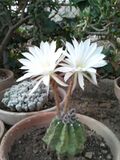Biology:Echinopsis
| Echinopsis | |
|---|---|

| |
| Echinopsis oxygona | |
| Scientific classification | |
| Kingdom: | Plantae |
| Clade: | Tracheophytes |
| Clade: | Angiosperms |
| Clade: | Eudicots |
| Order: | Caryophyllales |
| Family: | Cactaceae |
| Subfamily: | Cactoideae |
| Tribe: | Cereeae |
| Subtribe: | Trichocereinae |
| Genus: | Echinopsis Zucc. |
| Type species | |
| Echinopsis eyriesii, now Echinopsis oxygona | |
| Species | |
|
Around 20, see text | |
| Synonyms | |
| |
Echinopsis is a genus of cacti native to South America, sometimes known as hedgehog cactus, sea-urchin cactus or Easter lily cactus. (As of October 2023), there are about 20 accepted species, ranging from large and treelike types to small globose cacti. The name derives from echinos hedgehog or sea urchin, and opsis appearance, a reference to these plants' dense coverings of spines.
They are remarkable for the great size, length of tube, and beauty of their flowers, borne upon generally small and dumpy stems.
Taxonomy
Studies in the 1970s and 1980s resulted in several formerly separate genera being absorbed into Echinopsis. When very broadly circumscribed, Echinopsis sensu lato included over 100 species.[1] Some genera have been absorbed and then accepted again. For example, the genus name Trichocereus was given to a number of columnar cacti in 1909 by Vincenzo Riccobono. The genus was subsumed into Echinopsis in 1974 by Friedrich, along with Lobivia. In 2011, it was argued that Trichocereus was distinct from Echinopsis,[2] and a 2012 genetic and morphological study by Albesiano found Trichocereus to be monophyletic if it included three species of Harrisia.[3]
A 2012 genetic analysis of chloroplast DNA indicated Echinopsis was made up of several divergent lineages.[4] This was shown again in 2019.[1]
(As of October 2023), Plants of the World Online accepts Echinopsis more narrowly circumscribed to include only about 20 species.[5]
Species
Species as according to Plants of the World Online (As of September 2023):[5]
| Image | Scientific Name | Distribution |
|---|---|---|
 |
Echinopsis albispinosa K.Schum. | Argentina |
 |
Echinopsis aurea Britton & Rose | Argentina |
| Echinopsis breviflora (Backeb.) M.Lowry | Argentina (Salta) | |
 |
Echinopsis calochlora K.Schum. | Bolivia to Brazil (Mato Grosso do Sul) |
| Echinopsis chalaensis (Rauh & Backeb.) H.Friedrich & G.D.Rowley | Peru | |
 |
Echinopsis chrysantha Werderm. | Argentina |
 |
Echinopsis clavata (F.Ritter) D.R.Hunt | Bolivia |
 |
Echinopsis cuzcoensis (Britton & Rose) H.Friedrich & G.D.Rowley | Peru |
 |
Echinopsis densispina Werderm. | Argentina |
 |
Echinopsis haematantha (Speg.) D.R.Hunt | Argentina and Bolivia |
| Echinopsis jajoana (Backeb.) Blossf. | Argentina | |
 |
Echinopsis lageniformis (C.F.Först.) H.Friedrich & G.D.Rowley | Bolivia. |
 |
Echinopsis marsoneri Werderm. | Bolivia to Argentina (Jujuy, Salta). |
| Echinopsis oligotricha (Cárdenas) M.Lowry | Bolivia | |
 |
Echinopsis oxygona (Link) Zucc. ex Pfeiff. & Otto | Brazil, Uruguay and northern Argentina |
| Echinopsis rauschii Friedrich | Bolivia (Cochabamba) | |
 |
Echinopsis rojasii Cárdenas | Bolivia |
 |
Echinopsis tacaquirensis (Vaupel) H.Friedrich & G.D.Rowley | Bolivia |
| Echinopsis torrefluminensis M.Lowry | Bolivia | |
 |
Echinopsis werdermannii Frič ex Fleisch. | Paraguay |
Many hybrids exist, mostly between similar species but also between more distinct ones, such as the cross between Trichocereus pachanoi (now Trichocereus macrogonus var. pachanoi) and E. eyriesii (now E. oxygona) which was sold under the name "Trichopsis pachaniesii" by Sacred Succulents.
Distribution
Echinopsis species are native to South America (Argentina , Bolivia, Peru, Brazil , Paraguay and Uruguay).[5] They grow only in situations where the soil is sandy or gravelly, or on the sides of hills in the crevices of rocks.[citation needed]
Cultivation
This article needs editing for compliance with Wikipedia's Manual of Style. In particular, it has problems with style not being consistent with WP:NOTHOW. (October 2023) (Learn how and when to remove this template message) |
The growing and resting seasons for Echinopsis are the same as for Echinocactus.[citation needed] Research by J. Smith (former Curator at the Royal Botanic Gardens, Kew) showed that species like the Chile an Echinopsis cristata and its Mexican relatives thrive if potted in light loam, with a little leaf mould and a few nodules of limestone. The limestone keeps the soil open; it is important that the soil should be well drained.
Gallery
References
- ↑ 1.0 1.1 Guerrero, Pablo C.; Majure, Lucas C.; Cornejo-Romero, Amelia; Hernández-Hernández, Tania (2019). "Phylogenetic Relationships and Evolutionary Trends in the Cactus Family". Journal of Heredity 110 (1): 4–21. doi:10.1093/jhered/esy064. PMID 30476167.
- ↑ Schick, Robert (2011), "Echinopsis sensu stricto and Trichocereus: Differentiating the Genera", Cactus and Succulent Journal 83 (6): 248–255, doi:10.2985/0007-9367-83.6.248
- ↑ Albesiano, Sofía; Terrazas, Teresa (2012). "Cladistic Analysis of Trichocereus (Cactaceae: Cactoideae: Trichocereeae) Based on Morphological Data and Chloroplast Dna Sequences: Dedicated to Omar Emilio Ferrari (1936-2010)". Haseltonia 17: 3–23. doi:10.2985/1070-0048-17.1.2. https://www.researchgate.net/publication/280989243.
- ↑ Schlumpberger, Boris O.; Renner, Susanne S. (2012). "Molecular phylogenetics of Echinopsis (Cactaceae): Polyphyly at all levels and convergent evolution of pollination modes and growth forms". American Journal of Botany 99 (8): 1335–49. doi:10.3732/ajb.1100288. PMID 22859654.
- ↑ 5.0 5.1 5.2 "Echinopsis Zucc. — Plants of the World Online". https://powo.science.kew.org/taxon/urn:lsid:ipni.org:names:30001009-2.
Bibliography
- Edward F. Anderson, The Cactus Family (Timber Press, 2001) ISBN:0-88192-498-9, pp. 255–286
- K. Trout, Trout's Notes on San Pedro & related Trichocereus species (Sacred Cacti 3rd ed. Part B) (Moksha Press, 2005) ISBN:0-9770876-0-3
External links
- Cactus Culture for Amateurs by W. Watson (1889)
- Cactus Culture Volume 1: Trichocereus by Patrick Noll
- SucculentCity: Plant Profiles, Photographs & Cultivation Data
- Kuentz: Echinopsis (in French)
- Lohmueller: Echinopsis
- Mattslandscape; Echinopsis hybrids-growing culture
- Vimeo Video Echinopsis Cacti in Bloom
- echinopsis.com Photographs, Videos
- Echinopsis Cacti Flower Photographs, Videos
Wikidata ☰ Q131726 entry
 |



